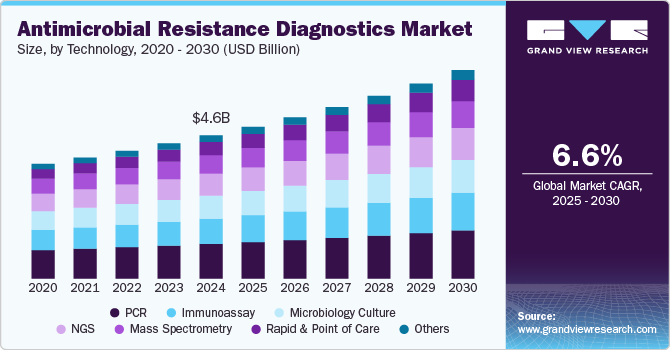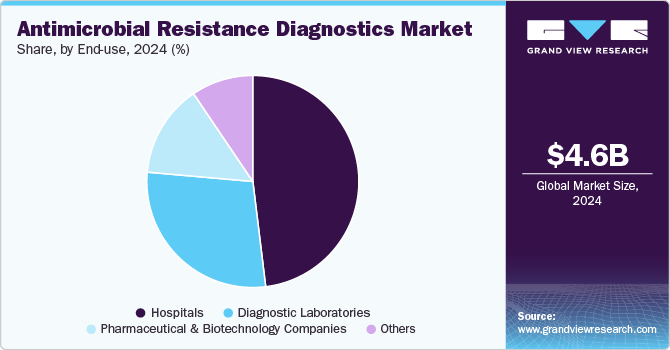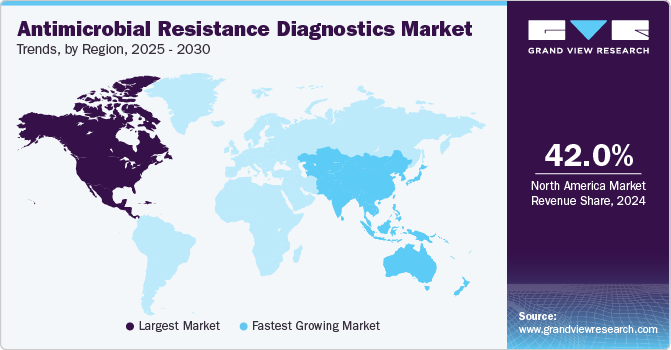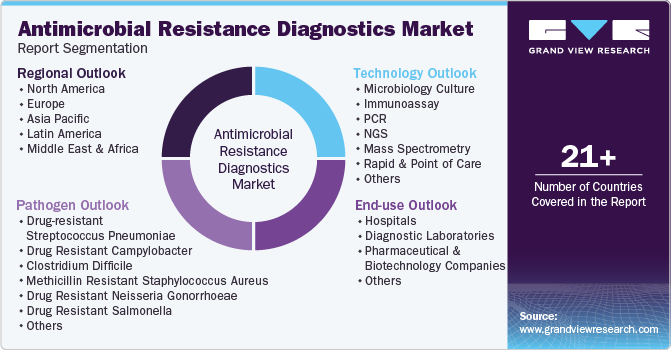
Antimicrobial Resistance Diagnostics Market Size, Share & Trends Analysis Report By Technology (Microbiology Culture, PCR), By End-use (Hospitals, Diagnostic Laboratories), By Pathogen, By Region, And Segment Forecasts, 2025 - 2030
- Report ID: GVR-4-68039-990-4
- Number of Report Pages: 120
- Format: PDF, Horizon Databook
- Historical Range: 2018 - 2023
- Forecast Period: 2024 - 2030
- Industry: Healthcare
Market Size & Trends
The global antimicrobial resistance diagnostics market size was estimated at USD 4.60 billion in 2024 and is projected to grow at a CAGR of 6.55% from 2025 to 2030. The high prevalence of pathogens such as Streptococcus pneumoniae, MRSA, and C. difficile, along with the increasing cases of antimicrobial-resistant (AMR) infections, is significantly driving market expansion. In addition, the demand for advanced diagnostic solutions to address AMR, coupled with growing regulatory approvals for these products, is further contributing to this growth. For example, in September 2021, MeMed's BV diagnostic test, which differentiates between bacterial and viral infections in point-of-care environments, received 510(k) approval from the U.S. FDA.

The growing threat of antimicrobial resistance (AMR) is expected to drive market growth. According to the CDC, approximately 2.8 million AMR cases occur annually in the U.S., and the United States Pharmacopeial Convention reports that AMR leads to around 700,000 deaths globally each year. This number could potentially rise to 10 million by 2050 if proper diagnosis and treatment of microbial infections are not implemented.
Governments worldwide are working to enhance diagnostic quality for accurate and point-of-care diagnoses. For example, the UK government has launched initiatives to incentivize R&D for new AMR diagnostics. By 2024, the UK aims to bridge R&D gaps, collaborate with global stakeholders to develop next-generation diagnostic tests, and promote AMR diagnostics research. In February 2020, the UK invested approximately USD 12 million in partnership with Nigeria to combat drug-resistant infections by upgrading laboratory equipment, improving public health surveillance, and training scientists and technicians.
The rise in regulatory approvals for advanced and accurate diagnostic solutions is expected to meet the growing market demand. For example, in October 2021, Hologic, Inc. launched the fully automated Novodiag molecular diagnostic system from Mobidiag Oy in Europe. This system, which integrates microarray and real-time PCR technology, enables on-demand testing for antimicrobial resistance and infectious diseases, identifying multiple pathogens from a single sample. In addition, in the same month, OpGen, Inc. received 510(k) clearance from the U.S. FDA to market its Acuitas AMR Gene Panel. This panel tests for 28 genetic antimicrobial resistance markers across various pathogens, aiding healthcare providers in managing resistant bacterial infections.
Moreover, leading industry players are collaborating to create innovative solutions aimed at addressing drug-resistant infections. For instance, in July 2022, Boehringer Ingelheim, bioMérieux, and Evotec SE formed a joint venture to develop actionable diagnostics and next-generation antibiotics to combat antimicrobial resistance. As part of this initiative, bioMérieux will focus on developing testing solutions for antibiotic resistance, with 80% of the investment dedicated to fighting AMR. In addition, in June 2024, Sysmex Astrego was announced as a winner of the Longitude Prize for its PA-100 AST System, which is a point-of-care test for urinary tract infections.
Technology Insights
The PCR segment dominated the market and accounted for the largest revenue share of 24.19% in 2024. Advancements in PCR technology, along with its widespread adoption due to its high accuracy, are key factors driving the significant share of this segment. The growing use of PCR tests for healthcare-associated infections (HAIs) such as MRSA and C. difficile is further boosting segment growth. In addition, the presence of strong and innovative product portfolios from leading market players is expected to further enhance demand in this segment. An example of a cutting-edge PCR solution is the PathoKey MP UTI ID & AMR PCR Test, developed by Vela Diagnostics, which detects AMR genes and urinary tract infection (UTI) pathogens. This test identifies genes responsible for resistance to five different antibiotics.
However, the rapid and point-of-care (PoC) diagnostic segment is projected to experience the fastest CAGR of 8.46% over the forecast period. The increasing demand for PoC and rapid diagnostics is driven by their benefits, including quick turnaround times, fast results, and cost-effectiveness. In addition, the strong product offerings in rapid diagnostics and growing research efforts to develop these solutions are expected to boost demand. For example, in November 2021, researchers at Washington University developed a technique capable of detecting antimicrobial resistance (AMR) within 90 minutes.
Pathogen Insights
In 2024, the methicillin resistant staphylococcus aureus segment held the largest market share at 28.33%. The rising incidence of MRSA in hospital settings is a key driver for the expansion of this segment. According to the CDC, about 33% of people carry Staphylococcus aureus in their noses without showing symptoms, but approximately two out of every 100 of these individuals become infected with MRSA. In addition, an increase in regulatory approvals for diagnostic tests targeting MRSA detection is further contributing to this growth. For example, in January 2020, the U.S. FDA approved a novel diagnostic test based on bacteriophage technology for MRSA detection. In recent years, the U.S. FDA also approved the Cobas vivoDx MRSA diagnostic test, designed for the quantification of MRSA, highlighting the focus on innovative diagnostic tools in this segment.
The Drug Resistant Streptococcus Pneumoniae (DRSP) segment is likely to grow with a lucrative CAGR of 7.74% over the forecast period. Increasing prevalence of DRSP infections, which are harder to treat due to resistance to common antibiotics such as penicillin and macrolides is a key factor for the segment growth. This has created a growing need for accurate and rapid diagnostic tools to detect resistant strains and improve treatment results. In addition, the rising awareness among healthcare providers about the importance of early detection and management of drug-resistant pathogens is leading to greater adoption of advanced diagnostic technologies like real-time PCR and next-generation sequencing (NGS).
End-use Insights
In 2024, the hospitals segment led the market, accounting for 48.07% of the revenue share. The growth of this segment is driven by several factors, including the rising incidence of hospital-acquired infections and increased hospitalizations due to antimicrobial-resistant (AMR) infections, which often lead to prolonged hospital stays.
The greater access to advanced diagnostic technologies, affordability, and improved healthcare coverage are contributing to the segment's expansion. Pathogens such as MRSA, CDI, and DRSP can cause serious conditions such as bloodstream infections, sepsis, pneumonia, and surgical site infections, making the high occurrence of these infections in hospitals a key factor supporting market growth. Furthermore, a study conducted in April 2022 by BD, Pfizer, and Merck revealed that over 270 hospitals in the U.S. saw a rise in antimicrobial resistance during the COVID-19 pandemic, highlighting the ongoing challenge posed by AMR infections in healthcare settings.

The diagnostic laboratories segment is expected to be the fastest-growing segment over the forecast period, with a projected CAGR of 7.42%. The growing prevalence of infectious diseases, combined with advancements in laboratory technology, is projected to propel segment growth. In addition, the availability of affordable diagnostic services and the widespread presence of laboratories capable of conducting various diagnostic procedures are expected to contribute to market expansion. Laboratory testing plays a crucial role in patient management by identifying emerging threats and delivering accurate results essential for effective treatment. CDC has also established its Antimicrobial Resistance (AR) laboratory network to facilitate rapid resistance diagnosis and inform local authorities to help combat the spread of resistant infections.
Regional Insights
North America antimicrobial resistance diagnostics market dominated the overall global market with a revenue share of 42.03% in 2024. The growth of the region is attributed to several factors, including the elevated risk of antimicrobial resistance, supportive government initiatives aimed at addressing AMR, and the existence of advanced healthcare infrastructure. In addition, the presence of major market players and their strategic initiatives are expected to further drive segment expansion in the years ahead. These elements collectively create a conducive environment for the development and adoption of innovative solutions in the fight against antimicrobial resistance.

U.S. Antimicrobial Resistance Diagnostics Market Trends
The U.S. antimicrobial resistance diagnostics marketheld a significant share of the North America market in 2024, fueled by the presence of key players and a large end user base. Furthermore, the U.S. invests heavily in research and development in the healthcare sector. This investment fuels advancements in diagnostic technologies and the development of new solutions for combating antimicrobial resistance.
Europe Antimicrobial Resistance Diagnostics Market Trends
The Europe antimicrobial resistance diagnostics market is experiencing significant growth. Many European countries face significant challenges related to antimicrobial resistance, with rising rates of drug-resistant infections. This situation drives the urgent need for effective diagnostic solutions to identify resistant pathogens and manage infections.
The UK antimicrobial resistance diagnostics market is experiencing significant growth due to healthcare improvements and technological advancements. The rising incidence of drug-resistant infections has increased awareness among healthcare providers and policymakers about the urgent need for effective diagnostic solutions. This urgency is reflected in various government initiatives aimed at combating AMR, such as the UK’s 20-Year Vision for Antimicrobial Resistance, which emphasizes early detection and management of resistant infections. In addition, the UK benefits from a robust healthcare infrastructure and a strong research community, fostering innovation and collaboration in developing new diagnostic technologies.
The Germany antimicrobial resistance diagnostics market is experiencing significant growth. Germany boasts a highly developed healthcare infrastructure characterized by advanced laboratories and medical facilities, which facilitates the integration and adoption of innovative diagnostic technologies.
Asia Pacific Antimicrobial Resistance Diagnostics Market Trends
The antimicrobial resistance diagnostics market in Asia Pacific is anticipated to experience the fastest CAGR over the forecast period, which is driven by significant advancements in healthcare infrastructure and technology. The increasing prevalence of infectious diseases and the rising incidence of drug-resistant infections in the region are the key factors for the market growth. Countries in the Asia Pacific are grappling with significant public health challenges related to antimicrobial resistance, prompting a heightened need for effective diagnostic tools to identify resistant pathogens and manage infections effectively.
The China Antimicrobial Resistance Diagnostics market is growing, driven by the rapid expansion of its biotechnology and pharmaceutical industries. China is making great strides in advancing its healthcare infrastructure, with significant investments in medical technology and diagnostic facilities. The rapid adoption of cutting-edge diagnostic tools, such as molecular testing and rapid point-of-care diagnostics, is helping healthcare professionals in China respond quickly and accurately to AMR challenges.
Latin America Antimicrobial Resistance Diagnostics Market Trends
The Latin America antimicrobial resistance diagnostics marketis experiencing significant growth,owing to increasing investments in pharmaceutical and biotechnology sectors, particularly in countries like Brazil and Argentina. Government initiatives aimed at combating antimicrobial resistance are also gaining momentum in the region. Several Latin American countries have developed national action plans that prioritize the surveillance of antimicrobial resistance, promote research and development in diagnostics, and encourage the appropriate use of antibiotics.
Middle East And Africa Antimicrobial Resistance Diagnostics Market Trends
The MEA antimicrobial resistance diagnostics market is expanding, driven by growing investments in the overall healthcare and life sciences sector, especially in countries like South Africa, Saudi Arabia, and the UAE.
The Saudi Arabia antimicrobial resistance diagnostics market is expanding due to increased healthcare investment and improved infrastructure. Saudi Arabia's government has prioritized public health and is actively implementing strategies to combat AMR as part of its Vision 2030 initiative. This includes the establishment of national action plans to enhance surveillance, promote research, and improve the overall management of antimicrobial use.
Key Antimicrobial Resistance Diagnostics Company Insights
The competitive scenario in the market for antimicrobial resistance diagnostics, with key players such as -bioMerieux, F. Hoffmann-La Roche Ltd., Abbott, Hologic, Inc., BD, and Danaher holding significant positions. Prominent market participants are focusing on increasing the customer base using acquisition strategies. For instance, in April 2022, bioMerieux announced to acquisition of Specific Diagnostics. This acquisition has strengthened its position in the global antimicrobial resistance diagnostics market.
Key Antimicrobial Resistance Diagnostics Companies:
The following are the leading companies in the antimicrobial resistance diagnostics market. These companies collectively hold the largest market share and dictate industry trends.
- bioMerieux
- F. Hoffmann-La Roche Ltd.
- Abbott
- Hologic, Inc.
- BD
- Danaher
- Accelerate Diagnostics, Inc.
- Molsid
- Vela Diagnostics
- Visby Medical, Inc.
- OpGen
View a comprehensive list of companies in the Antimicrobial Resistance Diagnostics Market
Recent Developments
-
In April 2022, bioMerieux announced an agreement to acquire Specific Diagnostics. This acquisition has strengthened its position in the global antimicrobial resistance diagnostics market
-
In September 2024, Telangana's chief minister announced the launch of an antimicrobial resistance plan to control antimicrobial resistance instances within the state
-
In July 2024, Gujarat state announced that they had launched a State Action Plan for the Containment of antimicrobials to control AMR within the state
Antimicrobial Resistance Diagnostics Market Report Scope
|
Report Attribute |
Details |
|
Market size value in 2025 |
USD 4.88 billion |
|
Revenue forecast in 2030 |
USD 6.70 billion |
|
Growth Rate |
CAGR of 6.55% from 2025 to 2030 |
|
Actual Data |
2018 - 2023 |
|
Forecast period |
2025 - 2030 |
|
Quantitative units |
Revenue in USD million/billion and CAGR from 2025 to 2030 |
|
Report coverage |
Revenue forecast, company ranking, competitive landscape, growth factors, and trends |
|
Segments covered |
Technology, pathogen, end-use, region |
|
Regional scope |
North America; Europe; Asia Pacific; Latin America; MEA |
|
Country scope |
U.S., Canada, Mexico, UK, Germany, France, Italy, Spain, Norway, Denmark, Sweden, China, Japan, India, Australia, Thailand, South Korea, Brazil, Argentina, South Africa, Saudi Arabia, UAE, Kuwait |
|
Key companies profiled |
bioMerieux; F. Hoffmann-La Roche Ltd.; Abbott; BD; Danaher; Accelerate Diagnostics, Inc.; Molsid; Vela Diagnostics; Visby Medical, Inc.; OpGen |
|
Customization scope |
Free report customization (equivalent up to 8 analyst working days) with purchase. Addition or alteration to country, regional & segment scope. |
|
Pricing and purchase options |
Avail customized purchase options to meet your exact research needs. Explore purchase options |
Global Antimicrobial Resistance Diagnostics Market Report Segmentation
This report forecasts revenue growth at country levels and provides an analysis on the latest industry trends and opportunities in each of the sub-segments from 2018 to 2030. For this study, Grand View Research has segmented the global antimicrobial resistance diagnostics market report based on technology, pathogen, end-use, and region.

-
Technology Outlook (Revenue, USD Million, 2018 - 2030)
-
Microbiology Culture
-
Immunoassay
-
PCR
-
NGS
-
Mass Spectrometry
-
Rapid & Point of Care
-
Others
-
-
Pathogen Outlook (Revenue, USD Million; 2018 - 2030)
-
Drug-resistant Streptococcus pneumoniae (DRSP)
-
Drug Resistant Campylobacter (DRC)
-
Clostridium difficile (CD)
-
Methicillin Resistant Staphylococcus Aureus (MRSA)
-
Drug Resistant Neisseria Gonorrhoeae (DRNG)
-
Drug Resistant Salmonella (DRNTS)
-
Others
-
-
End Use Outlook (Revenue, USD Million; 2018 - 2030)
-
Hospitals
-
Diagnostic Laboratories
-
Pharmaceutical & Biotechnology Companies
-
Others
-
-
Regional Outlook (Revenue, USD Million; 2018 - 2030)
-
North America
-
U.S.
-
Canada
-
Mexico
-
-
Europe
-
UK
-
Germany
-
France
-
Italy
-
Spain
-
Norway
-
Denmark
-
Sweden
-
-
Asia Pacific
-
Japan
-
China
-
India
-
Australia
-
South Korea
-
Thailand
-
-
Latin America
-
Brazil
-
Argentina
-
Mexico
-
-
Middle East & Africa
-
South Africa
-
Saudi Arabia
-
UAE
-
Kuwait
-
-
Frequently Asked Questions About This Report
b. The global antimicrobial resistance diagnostics market size was estimated at USD 4.60 billion in 2024 and is expected to reach USD 4.88 billion in 2025.
b. The global antimicrobial resistance diagnostics market is expected to grow at a compound annual growth rate of 6.55% from 2025 to 2030 and is expected to reach USD 6.70 billion by 2030.
b. The PCR segment is expected to dominate the antimicrobial resistance diagnostics market with a share of 24.19% in 2024 due to technological advancements, high penetration of PCR technology, and increasing adoption of PCR tests for HAIs.
b. Some key players operating in the antimicrobial resistance diagnostics market include BIOMERIEUX, F. Hoffmann-La Roche Ltd, Abbott, BD, and Danaher among others.
b. The increasing risk of developing drug-resistant infections, the increasing introduction of technologically advanced tests, and government initiatives to reduce AMR disease burden are the major factors driving the antimicrobial resistance diagnostics market growth over the forecast period.
b. North America held the largest share of 43.02% in 2024 and is expected to register a lucrative growth rate over the forecast period. It is attributable to the supportive government policies to combat AMR, advanced healthcare infrastructure, and the presence of leading players in the region.
We are committed towards customer satisfaction, and quality service.
"The quality of research they have done for us has been excellent."




